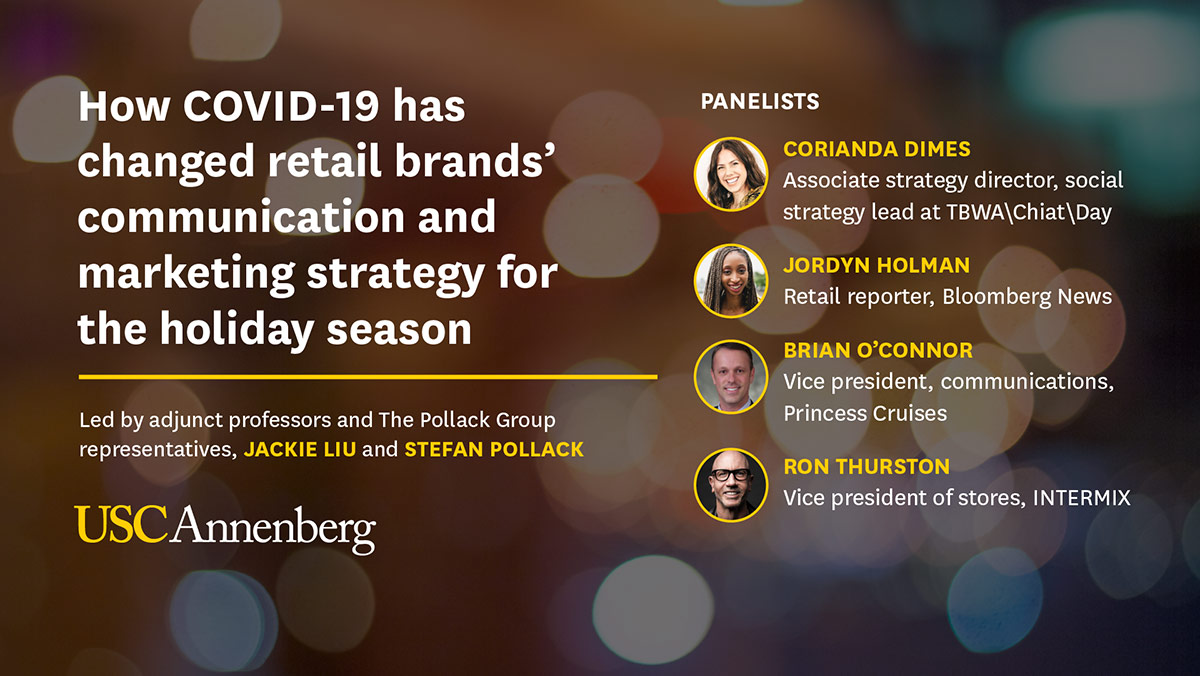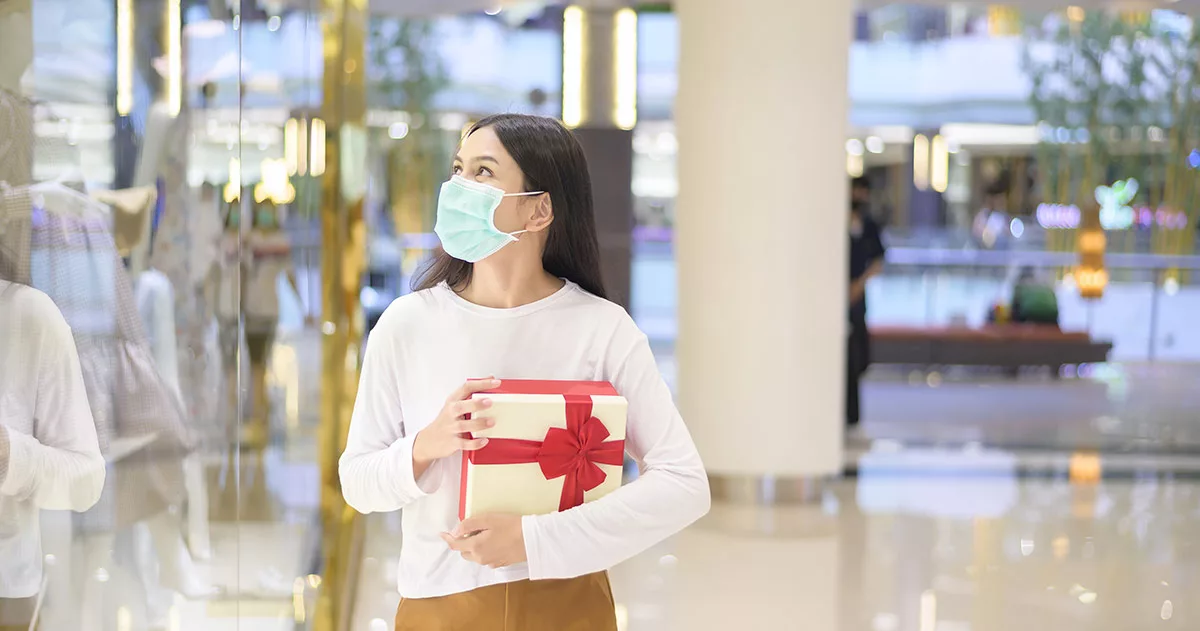By Jesse Shuter
The Pollack Group partnered with the USC Annenberg School for Communication and Journalism to host a webinar about how brands are projecting to navigate the ongoing COVID-19 pandemic during the holiday season.
The webinar featured four professionals who currently work in different facets of the retail, travel, and hospitality industries. The panel, hosted by the agency’s vice president, Jacqueline Liu, and, president, Stefan Pollack, featured Corianda Dimes, associate strategy director and social strategy lead at TBWA/Chiat/Day; Jordyn Holman, a retail reporter for Bloomberg News; Brian O’Connor, vice president of communications for Princess Cruises; and Ron Thurston, vice president of stores at INTERMIX.
The webinar was focused on how the retail and travel industries have been affected by COVID-19; how customer habits have changed during the era of social distancing; what companies are doing to recover going forward, and how young professionals can develop careers in the industry. Here are the key takeaways.

Changing Customer Habits
One of the key points was that companies have had to pivot their strategies based on how customers shifted shopping patterns in a COVID-19 age. For Thurston, whose clientele look for higher-end fashion, there has been a shift away from buying party clothing or just “going out” clothes, to buying luxury-at-home clothes and feeling comfortable. Thurston laughed as he said, “Can I trade out that sequin dress for a cashmere tracksuit?”, reflecting a sentiment of his clients.
What are the brands that are doing well now? Well obviously, those focusing on comfort, whether it be clothing or furnishings. “All the brands offering “comfort” won early in the pandemic, like Lululemon or Athleta,” Holman noted. “And with home improvement – like Home Depot and Lowe’s – you would look at their sales and be confused that there’s a recession in place. People are upgrading their homes, building home offices, and students are buying desks.”
Both Thurston and Holman noted that while the industry has indeed taken a hit, luxury retailers and high-end malls are still surprisingly being frequented by customers. Most malls, however, are struggling right now due to the same reasons they had made a comeback in recent years. “For a decade, the [mall] industry said we needed to bring experiential shopping to bring them back. We need to give people a reason to stay and congregate. But in a social distancing world, that’s off the table,” Holman said. COVID-19 has significantly taken away a customer’s desire for an in-person experience in favor of the safety and convenience of at-home shopping.
Shifting the Strategy
The holiday season brings with it a lot of crucial shopping days for businesses – not only for holidays themselves, but days like Black Friday, Cyber Monday, or Amazon Prime Day. However, the pandemic reflects the bigger trend that “doorbuster” deals are going away and that companies are releasing deals earlier and earlier while investing heavily in online shopping.
READ MORE: How U.S. Companies Should Adapt To The ‘New Normal’ In Communications
This year, many retailers are closing their stores on Thanksgiving. It is a nice gesture for their workers, but also a nod to the bigger trend. “It goes to marketing to retail workers are working harder than they ever have done…If you talk about the values of what you’re doing to protect workers, it does make your brand seem benevolent. But it’s not super clear how sales were on Thanksgiving Day – it’s more like Black Friday and Cyber Monday,” Holman said. Retailers are pushing their online sales harder than ever, and many brands are putting in the effort to ensure their websites are running smoothly and fast in order to handle this shift.
For the travel industry, safety is the name of the game now. Cruises and the travel industry as a whole have seen the biggest setbacks due to outbreaks on the very experiences they are trying to sell. But industry leaders aren’t losing confidence. Princess Cruises has been working on a proprietary wearable device that serves as a contactless room key, credit card, and more. “This device is going to be a great way for us to return quickly while offering a safe cruising experience during this new normal,” O’Connor said.
He also pointed out that optimism is strong for an industry rebound. “Consumer surveys have shown people will cut their spending in other places to save for, and prioritize, for travel,” O’Connor added. “People who cruise really love to cruise.” Princess Cruises’ guests get a chance to look into what is currently happening on their ships, and even their is president doing a virtual web series as a way of customer engagement. When cruises resume, O’Connor noted however that ships will not be booked to capacity, buffets and onboard entertainment will undergo changes, and protocols will shift to balance a pent-up demand and necessary precautions.
Marketing in a Social Age
The approach to marketing a company is changing with the evolution of social media, and the pandemic is only accelerating these existing trends. For a strategy expert like Dimes, this means more conversions and actual purchases through digital media. “The importance of social has always been a thing, but its power in being the last step o shopping is significant as people factor it into their holiday plans,” Diems said. “We no longer send people to the store with our communications and activations, so where do we send them for e-commerce?”
There is also a movement towards socially responsible shopping. “Price sensitivity and brand loyalty are changing because of COVID-19,” Dimes said. “More people are shopping locally and more are consciously shopping black-owned businesses.” She also noted how companies and marketers are now seeing social media as both a channel and a tool, and that it must be used differently for different purposes. A social media campaign to drive awareness and impressions must be strategized much differently than a normal campaign that drives purchases and conversions.
READ MORE: The Five Stages Of COVID-19 Responses From The Travel And Tourism Sector
Each panelist echoed how businesses and brands must be more responsive and quicker at adapting than ever before. Even as unpredictability becomes the norm, opportunities arise. Thurston has seen business spike in areas where wealthy clients have second homes, such as The Hamptons, Aspen, and Connecticut. As a response, an INTERMIX store that was originally open from Memorial Day until Labor Day made the decision to go year-round in 2020. “What I thought would be temporary, with clients going back to the city, hasn’t happened. Business continues to be very strong in secondary markets, especially as people entertain at home,” Thurston said.
What Should Job-Hunters Know?
Thurston reminded the panel listeners that the retail industry is enormous, with over 40 million workers, and that the opportunities within are endless. “Yes, there will be fewer brands and stores, but that doesn’t mean fewer job opportunities or growth,” Thurston said.
Holman and O’Connor both emphasized the importance of networking, with Holman focusing on the power of social media in creating a personal brand. “Reporters switch companies all the time, but you can always bring your followers,” she said.
Dimes also discussed the advantages of working in social media. “I find that people who grow up in social media are less concerned about working in lanes. They think about building communities, and that skill is in massive demand right now,” Dimes said. She added that people can’t just be tactical; aspiring professionals must be able to communicate how their work connects to business objectives or risk being pigeonholed into social media. “If you can weaponize what you do in social, it can translate over to strategy.”
For more agency insights, visit our WellRed archives






